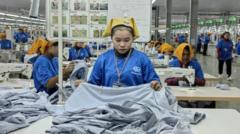As the U.S. and China engage in a fraught trade battle, Southeast Asia stands at a crossroads, facing difficult decisions amidst the turmoil created by tariffs on Chinese goods. A recent shift in markets due to former President Donald Trump's tariffs has led to the emergence of local competitors in Vietnam and beyond. For Vietnamese entrepreneur Hao Le, whose company SHDC Electronics exports $2 million worth of phone accessories monthly to the U.S., the anticipation of a looming 46% tariff is alarming. "That would be catastrophic for our business," he explained, emphasizing the struggle local firms face against the influx of Chinese products due to the earlier tariffs.
The trade landscape has dramatically evolved, with tariffs sending a wave of cheap Chinese imports to Southeast Asia, impacting local manufacturers and stifling growth. At the same time, these tariffs have facilitated the entrance of new players in global supply chains keen on reducing their reliance on Chinese goods. However, as Trump resumes discussions about potential new tariffs, nations like Vietnam and Indonesia are acutely aware of the possibility that these channels may soon be closed.
In the face of impending tariffs, Southeast Asian leaders are navigating complex relationships. Chinese President Xi Jinping has recently visited countries like Vietnam and Malaysia, advocating for unity against U.S. tariffs. Malaysian Trade Minister Tengku Zafrul Aziz articulated a desire to maintain a balance, stating that Malaysia would not choose between China and the U.S.
As Southeast Asia's economies, which include strong players like Thailand and Indonesia, strategize to avoid the brunt of U.S. tariffs, they are simultaneously trying to fortify bilateral relations with both economic giants. With the U.S. being a crucial market and China as a significant trade partner, any shift in tariffs could impact their aspirations in burgeoning sectors ranging from electronics to electric vehicles.
Despite Xi’s efforts to rally Southeast Asia against what he terms as "bullying" from the U.S., local businesses are apprehensive. Many fear a further influx of Chinese products if tariffs on Chinese goods lead to competitive pressure on local markets. In Indonesia, Isma Savitri from the sleepwear brand Helopopy notes that “ultra-cheap Chinese products” jeopardize small businesses.
The fabric of trade in Southeast Asia has been complex, with the region historically balancing trade and economic partnerships with both China and the U.S. A past wave of protectionist measures has arisen from local companies’ demands to shield themselves from the adverse impacts of strong Chinese competition. Governments have taken initiatives in imposing anti-dumping duties and heightened scrutiny on imports.
Key economic sectors are being tested. For instance, the Malaysian rubber industry, which dominates global medical glove production, now finds itself in a favorable position to capture market share previously held by China.
As the region grapples with these changes, it faces a delicate balancing act. The uncertainty over the reintroduction of tariffs has compelled nations to reevaluate their dependence on any single market while keeping one eye on maintaining harmonious relations with both the U.S. and China. The outcome of this economic tug-of-war will determine not only the future of these nations but also the broader landscape of global trade in the years to come.





















